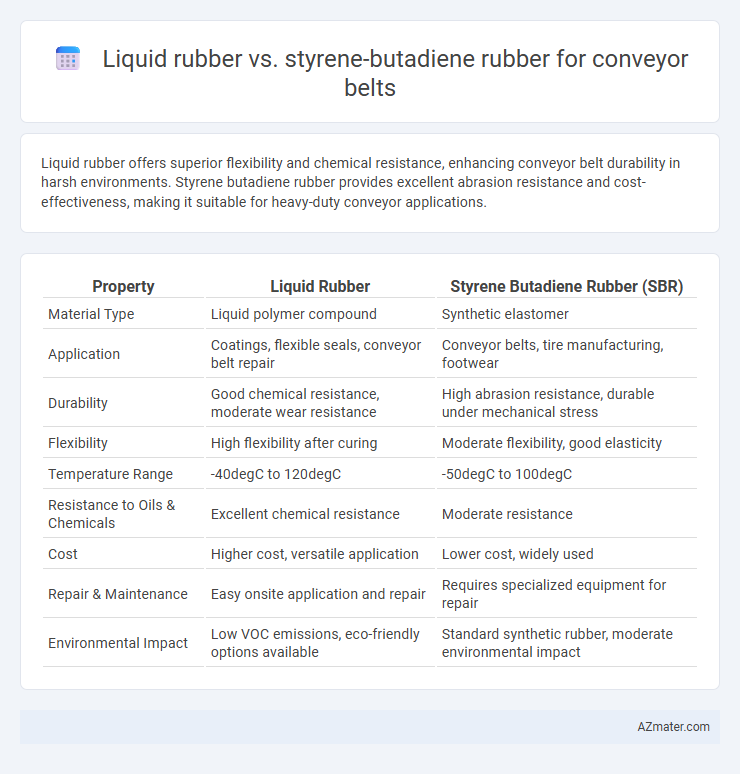Liquid rubber offers superior flexibility and chemical resistance, enhancing conveyor belt durability in harsh environments. Styrene butadiene rubber provides excellent abrasion resistance and cost-effectiveness, making it suitable for heavy-duty conveyor applications.
Table of Comparison
| Property | Liquid Rubber | Styrene Butadiene Rubber (SBR) |
|---|---|---|
| Material Type | Liquid polymer compound | Synthetic elastomer |
| Application | Coatings, flexible seals, conveyor belt repair | Conveyor belts, tire manufacturing, footwear |
| Durability | Good chemical resistance, moderate wear resistance | High abrasion resistance, durable under mechanical stress |
| Flexibility | High flexibility after curing | Moderate flexibility, good elasticity |
| Temperature Range | -40degC to 120degC | -50degC to 100degC |
| Resistance to Oils & Chemicals | Excellent chemical resistance | Moderate resistance |
| Cost | Higher cost, versatile application | Lower cost, widely used |
| Repair & Maintenance | Easy onsite application and repair | Requires specialized equipment for repair |
| Environmental Impact | Low VOC emissions, eco-friendly options available | Standard synthetic rubber, moderate environmental impact |
Overview of Conveyor Belt Rubber Materials
Liquid rubber and Styrene Butadiene Rubber (SBR) are prominent materials used in conveyor belt manufacturing, each offering distinct advantages. SBR is widely favored for its excellent abrasion resistance, elasticity, and cost-effectiveness, making it suitable for heavy-duty conveyor belts in industries like mining and construction. Liquid rubber provides superior flexibility, enhanced waterproofing, and chemical resistance, ideal for specialized conveyor applications requiring sealing properties and durability under harsh environmental conditions.
Introduction to Liquid Rubber
Liquid rubber is a versatile polymer used as a coating or binder in conveyor belts, offering excellent waterproofing, flexibility, and chemical resistance compared to traditional materials. Its seamless application creates a durable, elastic surface that enhances abrasion resistance and reduces surface fatigue. Styrene butadiene rubber (SBR), while commonly used for conveyor belts due to its good abrasion resistance and cost-effectiveness, lacks the superior waterproofing and chemical stability that liquid rubber provides.
Introduction to Styrene Butadiene Rubber (SBR)
Styrene Butadiene Rubber (SBR) is a synthetic elastomer widely used in conveyor belts due to its excellent abrasion resistance and moderate heat resistance, making it suitable for heavy-duty material handling. Compared to liquid rubber alternatives, SBR offers enhanced mechanical strength and durability, essential for continuous operation in demanding industrial environments. Its balanced properties of flexibility and toughness contribute to improved conveyor belt lifespan and reliability under various working conditions.
Mechanical Properties Comparison
Liquid rubber offers superior elasticity and tensile strength compared to styrene butadiene rubber (SBR), enhancing conveyor belt durability under heavy loads. SBR provides moderate abrasion resistance but exhibits lower resilience and flexibility, resulting in reduced mechanical performance over time. Conveyor belts utilizing liquid rubber show improved resistance to cracking and wear, making them more suitable for high-stress industrial applications.
Abrasion and Wear Resistance
Liquid rubber offers superior abrasion resistance compared to styrene butadiene rubber (SBR) due to its flexible molecular structure, which enhances durability under continuous friction. SBR provides moderate wear resistance but tends to degrade faster in high-abrasion environments typically encountered in conveyor belt applications. For conveyor belts requiring prolonged service life and high resistance to surface wear, liquid rubber formulations deliver enhanced performance and longevity.
Chemical and Environmental Resistance
Liquid rubber exhibits superior chemical resistance compared to styrene butadiene rubber (SBR), effectively withstanding exposure to oils, solvents, and various industrial chemicals commonly encountered in conveyor belt applications. Styrene butadiene rubber offers moderate resistance but tends to degrade faster when in contact with harsh chemicals and acidic or alkaline environments. Environmentally, liquid rubber demonstrates enhanced durability against ozone, UV radiation, and extreme temperatures, making it a more resilient choice for conveyor belts operating in challenging outdoor or chemical-heavy settings.
Flexibility and Elongation Characteristics
Liquid rubber exhibits superior flexibility and elongation compared to Styrene Butadiene Rubber (SBR) in conveyor belt applications, enabling better adaptation to dynamic loading and continuous flexing. SBR offers moderate elongation but often falls short in sustaining high deformation without cracking, limiting its performance in high-flex environments. Enhanced elongation and flexibility of liquid rubber contribute to reduced wear and increased lifespan of conveyor belts under rigorous operational conditions.
Cost Efficiency and Availability
Liquid rubber offers superior cost efficiency for conveyor belts due to lower material and application costs, combined with reduced downtime during repairs, making it a budget-friendly option for maintenance. Styrene butadiene rubber (SBR) is widely available and provides reliable performance, but its higher initial cost and limited repair flexibility may impact overall expenses. The widespread distribution of SBR ensures steady supply, while liquid rubber's growing market presence improves accessibility, balancing cost and availability considerations.
Typical Industry Applications
Liquid rubber offers superior adhesion and flexibility, making it ideal for conveyor belts in food processing and pharmaceutical industries where seamless, hygienic surfaces are critical. Styrene butadiene rubber (SBR) provides excellent abrasion resistance and durability, commonly used in mining and construction sectors requiring heavy-duty conveyor belts. Both materials serve specialized roles, with liquid rubber prioritizing chemical resistance and easy repair while SBR excels in high-wear, mechanical stress environments.
Choosing the Right Rubber for Your Conveyor Belt
Liquid rubber offers superior flexibility and seamless application, making it ideal for conveyor belts requiring corrosion resistance and easy repairs. Styrene butadiene rubber (SBR), known for its excellent abrasion resistance and durability, excels in heavy-duty conveyor belt applications facing intense wear and tear. Selecting the right rubber depends on operational conditions like exposure to chemicals, mechanical stress, and maintenance needs, with liquid rubber favored for customization and SBR preferred for robust performance.

Infographic: Liquid rubber vs Styrene butadiene rubber for Conveyor belt
 azmater.com
azmater.com